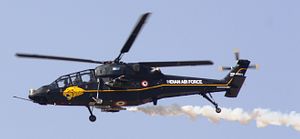An Indian Army helicopter successfully test fired the third-generation anti-tank guided missile (ATGM) Helina at the Pokhran test range in the Thar Desert region in northwestern India earlier this month, the Indian Ministry of Defense (MoD) announced in an August 19 statement.
“The weapon system has been tested for its full range,” according to the MoD. “The ‘Helina’ weapon system released smoothly from the launch platform has tracked the target all through its course and hit the target with high precision. All the parameters have been monitored by the telemetry stations, tracking systems, and the helicopters.”
The MoD claims that the Helina ATGM “is one of the world’s most advanced anti-tank weapons.” The indigenously designed and built Helina is the air-launched variant of the Nag, a fire-and-forget ATGM with an estimated range of 4 kilometers. (The Helina’s range is estimated at between 7 to 8 kilometers.)
Notably, the Nag is fired from the Nag Missile Carrier (NAMICA), an Indian license-produced variant of the Soviet-era BMP-II armored infantry fighting vehicle, whereas the Helina is launched from twin-tube stub wing-mounted launchers on board Hindustan Aeronautics Limited’s (HAL) Light Combat Helicopter (LCH) and Dhruv Advanced Light Helicopters (ALH).
The August 19 statement did not specify whether the ATGM was test fired from either an LCH or ALH, although the more likely platform is the armed variant of the latter, dubbed HAL Rudra. The Indian Army’s Army Aviation Corps (AAC) intends to induct a total of 114 LCHs, while the Indian Air Force (IAF) placed an order for 65 helicopters. As I explained:
LCH prototypes have been undergoing extensive testing including high-altitude and weapons systems trials in 2016 and 2017. The LCH, which first took to the air in May 2010, has been developed to close a capability gap that became apparent during the 1999 Kargil War when the Indian military lacked attack helicopters capable of operating at high altitudes.
(…)
Consequently, the LCH, a derivative of the HAL Dhruv helicopter, has been primarily designed for high-altitude warfare – HAL and French engine-maker, Turbomeca, jointly designed a special engine optimized for extreme altitudes – and has an operational ceiling limit of 6,000–6,500 meters (19,700–21,300 feet).
Initial operating capability for the LCH is expected by the end 2018. The Indian military currently operates over 100 HAL Dhruv helicopters of all variants. India’s Defense Research and Development Organization (DRDO) has been working on the Nag and Helina ATGMs for over a decade and it remains unclear when either of the two missiles will be inducted into service. The Indian military has repeatedly commented on the unsatisfactory performance of both weapons systems in comparison to foreign products including the U.S.-made FGM-148 Javelin and AGM-114R-3 Hellfire-II missiles, as well as the Israeli Spike ATGM.































